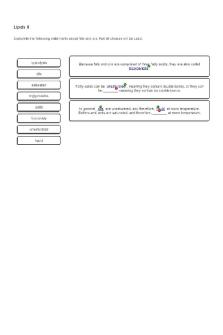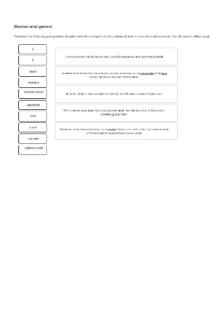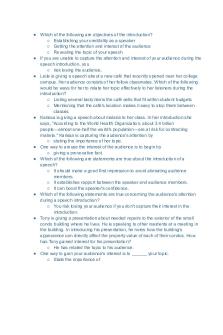Chapter 4 mcgraw hill connect answers PDF

| Title | Chapter 4 mcgraw hill connect answers |
|---|---|
| Author | Smithidon Smithicus |
| Course | Change Management |
| Institution | Southern Alberta Institute of Technology |
| Pages | 21 |
| File Size | 609 KB |
| File Type | |
| Total Downloads | 77 |
| Total Views | 140 |
Summary
Managing organizational change chapter 4 Mcgrawhill connect smartbook quiz answers, doo doo doo, daa daa daa. Ladi dooodle day....
Description
Multiple Select Question Select all that apply Which of the following are factors of the six-box organizational model? (Check all that apply.) Multiple select question.
Structure
Purposes
Systems
Rewards
Staff
Multiple Select Question Select all that apply Based on the 7-S framework, identify the factors that influence organizational effectiveness. (Check all that apply.) Multiple select question.
Superiority
Superordinate goals
Leadership
Systems
Staff
Multiple Select Question Select all that apply Which of the following statements are true of the star model of organizational design? (Check all that apply.) Multiple select question.
Processes and lateral capability form the basis for making other design decisions.
People practices are related to the organization's human resource policies and practices.
Changes in one element are often predictable and they seldom affect other elements.
Organizational performance will decline if one or more elements are out of alignment with others.
Multiple Select Question Select all that apply Identify the organizational metaphors associated with the symbolic frame of the four-frame model of organizational change. (Check all that apply.)
Multiple select question.
Carnival
Jungle
Theatre
Factory
Temple
Multiple Select Question Select all that apply According to Warner Burke (2013), which of the following are ways in which explicit models are useful? (Check all that apply.) Multiple select question.
They help highlight priorities.
They provide a new language for each stakeholder group.
They help simplify multivariate situations.
They allow flexibility of the choice of sequences of actions in change processes.
Multiple Choice Question Which of the following is true of gap analysis? Multiple choice question.
It is flexible with regard to timescale and focus.
It concerns an organization's dominant capabilities and attributes that distinguish it from competitors.
It provides a new language for each stakeholder group.
It is adaptable and discontinuous.
Multiple Choice Question In the context of the star model of organizational design, _____ refers to the formal authority relationships and grouping of activities, as depicted on an organization chart. Multiple choice question.
strategy
structure
style
Function
Multiple Choice Question Identify a true statement about scenario planning. Multiple choice question.
It concerns an organization's dominant capabilities and attributes that distinguish it from competitors.
It is adaptable and discontinuous.
It encourages creative "blue skies" decision making.
Multiple Choice Question In context of Donald Hambrick and James Fredrickson's framework that characterizes organization strategy, the current term associated with the question, "How will we achieve our mission?" is _____. Multiple choice question.
tactics
pace
corporate mission
competitive logic
Multiple Choice Question Identify a disadvantage of gap analysis. Multiple choice question.
It does not require coalitions to be formed.
It is very complicated.
It often suggests a felt need for deep, transformational change.
It is not very flexible.
Multiple Choice Question _____ is a phenomenon of adoption of inappropriate strategies that occurs when assumptions fail to reflect key elements of the business environment. Multiple choice question.
Strategic drift
Differentiation
Economic logic
Strategic management
Multiple Select Question Select all that apply Which of the following are factors of the six-box organizational model? (Check all that apply.) Multiple select question.
Systems
Staff
Purposes
Structure
Rewards
True or False Question True or false: The disadvantage of using strategic inventory is that it becomes a listing of "perceived weaknesses," "perceived strengths," and so on. True false question. True False
Multiple Choice Question The point of PESTLE analysis is to identify the _____.
Multiple choice question.
budgetary constraints of an organization
organizational and human needs at present
potential of the human capital in an organization and chart out an adequate reward system
environmental factors that affect an organization at present and in the future
Multiple Select Question Select all that apply Which of the following are the elements of the cultural web of an organization? (Check all that apply.) Multiple select question.
Inventory
The paradigm
Strategic drift
Symbols
Rituals and routines
Stories
Multiple Choice Question _____ involves the imaginative development of one or more likely pictures of the characteristics of potential futures for an organization, sometimes considering "best-case/worst-case" possibilities. Multiple choice question.
The star model
Gap analysis
The four-frame model
Scenario planning
Multiple Select Question Select all that apply Which of the following are remedial actions that can be taken when an organization's receptiveness to change is low? (Check all that apply.) Multiple select question.
Providing adequate resources to support change
Ensuring that key positions are held by low-performing employees to motivate change
Developing change management capabilities across the organization
Aligning performance management and rewards systems with company goals
Developing learning organization capabilities
Multiple Select Question Select all that apply According to the framework developed by Donald Hambrick and James Fredrickson (2001), which of the following are the mutually reinforcing elements of organization strategy? (Check all that apply.) Multiple select question.
Information strategy
Staging
Controls
Arenas
Differentiators
Economic logic
Vehicles
Multiple Choice Question _____ is defined as a dynamic capability pertaining to knowledge creation and utilization that improves a firm's ability to gain and sustain a competitive advantage. Multiple choice question.
Organizational restructuring
Absorptive capacity
Holistic problem-solving
Strategic drift
Multiple Choice Question _____ is about the future, committing resources to activities based on premises, assumptions, and beliefs about an organization's environment, its mission, and the core competencies needed to accomplish that mission. Multiple choice question.
Structure
Economic logic
Strategy
Process
Multiple Select Question Select all that apply Identify the ways in which an organization's absorptive capacity can be increased. (Check all that apply.) Multiple select question.
By using cross-functional teams and job rotation and encouraging the sharing of knowledge
By enforcing stricter rules, procedures, and routines
By increasing the exposure of staff to external networks
By narrowing employee participation in management decision making
Multiple Choice Question Identify a true statement about strategic inventory. Multiple choice question.
It encourages creative "blue skies" decision making.
It provides a new language for each stakeholder group.
It is adaptable and discontinuous.
It involves a more sophisticated analysis than the one provided by SWOT analysis.
Multiple Select Question Select all that apply Which of the following are considerations for managing a balanced force field? (Check all that apply.) Multiple select question.
An increase in the driving forces can frequently lead to an increase in the resisting forces.
Organizational change usually depends on individual preferences and not group behavior.
An increase in the resisting forces is generally preferable.
Group norms are an important force in shaping and resisting organizational change.
Multiple Select Question Select all that apply Which of the following are true about the value of mapping the cultural web of an organization? (Check all that apply.) Multiple select question.
It is adaptable and discontinuous.
It questions traditional habits and norms.
It provides a new language for each stakeholder group.
It highlights potential barriers to change.
Multiple Select Question Select all that apply Identify the beliefs that underpin an individual's change readiness. (Check all that apply.) Multiple select question.
The belief that change is necessary
The belief that the individual's effort is a futile attempt toward change
The belief that an individual can implement change without any support from the organization
The belief that the management will provide information and resources
Multiple Select Question Select all that apply Identify the practical issues highlighted by a simple assessment of organizational receptiveness to change. (Check all that apply.) Multiple select question.
Some conditions cannot be strengthened irrespective of the actions taken.
Actions must be taken to weaken the conditions when receptiveness is low.
Actions must be taken to strengthen the conditions when receptiveness is low.
Some conditions are likely to improve simply by waiting.
Multiple Select Question Select all that apply Which of the following dimensions of absorptive capacity rely on internal capabilities, relationships, and systems? (Check all the options that apply.) Multiple select question.
Acquisition
Exploitation
Transformation
Restructuring
Assimilation
Multiple Select Question Select all that apply Which of the following are the main purposes of force-field analysis? (Check all that apply.) Multiple select question.
To analyze the strengths, weaknesses, and opportunities of an organization
To assess whether an organization is ready for a change initiative
To identify and prioritize the groundwork that may be required for implementation to occur
To assess the budgetary requirements of an organization
Multiple Select Question Select all that apply In context of the factors that influence individual change readiness, which of the following factors do external pressures include? (Check all that apply.) Multiple select question.
New regulations
Technology changes
Change in participation
Industry changes
Professional group memberships
Change in leadership
Fill in the Blank Question Fill in the blank question.
A(n) is anyone who is likely to be affected by an organizational change and who can directly or indirectly influence the outcomes....
Similar Free PDFs

McGraw-Hill Connect Chapter 1
- 5 Pages

Connect Chapter 4 Answers
- 12 Pages

Connect Chapter 6 Answers
- 12 Pages
![[McGraw Hill] Biologia marina 6Ed (2007)](https://pdfedu.com/img/crop/172x258/z4xp2vpve8vp.jpg)
[McGraw Hill] Biologia marina 6Ed (2007)
- 514 Pages
Popular Institutions
- Tinajero National High School - Annex
- Politeknik Caltex Riau
- Yokohama City University
- SGT University
- University of Al-Qadisiyah
- Divine Word College of Vigan
- Techniek College Rotterdam
- Universidade de Santiago
- Universiti Teknologi MARA Cawangan Johor Kampus Pasir Gudang
- Poltekkes Kemenkes Yogyakarta
- Baguio City National High School
- Colegio san marcos
- preparatoria uno
- Centro de Bachillerato Tecnológico Industrial y de Servicios No. 107
- Dalian Maritime University
- Quang Trung Secondary School
- Colegio Tecnológico en Informática
- Corporación Regional de Educación Superior
- Grupo CEDVA
- Dar Al Uloom University
- Centro de Estudios Preuniversitarios de la Universidad Nacional de Ingeniería
- 上智大学
- Aakash International School, Nuna Majara
- San Felipe Neri Catholic School
- Kang Chiao International School - New Taipei City
- Misamis Occidental National High School
- Institución Educativa Escuela Normal Juan Ladrilleros
- Kolehiyo ng Pantukan
- Batanes State College
- Instituto Continental
- Sekolah Menengah Kejuruan Kesehatan Kaltara (Tarakan)
- Colegio de La Inmaculada Concepcion - Cebu



![[Book]International-Marketing-15th - McGraw Hill](https://pdfedu.com/img/crop/172x258/1nrxeg6epo2o.jpg)







